The 2,200 years of Turkestan history have played host to some of the most important civilizations in the world. The area is a wide expanse of territory, stretching from the Caspian Sea and the southern part of the Ural Mountains in the west, Siberia in the north, Iran, Afghanistan and Tibet in the south, and China and Mongolia to the east.
Today, the part of Turkestan that includes Kazakhstan, Kyrgyzstan, Tajikistan, Uzbekistan and Turkmenistan is known as West Turkestan, and the area that has been under Chinese captivity for the last two centuries is known as East Turkestan. The geographical and strategic importance of Turkestan is obvious from the great interest shown in the area by Russia and China, the two regional superpowers. Russia and China have both played very important roles in Turkestan history, which is why it is divided into two parts today.
 |
| "Mankind! We created you from a male and female, and made you into peoples and tribes so that you might come to know each other. The noblest among you in Allah's Sight is the best in conduct. Allah is All-Knowing, All-Aware." (Surat al-Hujurat: 13) |
Behind those two countries' refusal to give the region up, no matter what cost, is its strategic position and its rich underground resources. For Russia, the Turkish states in the west, and for China, East Turkestan, are important reserves of raw materials.
Following the Bolshevik Revolution, Russia set up a powerful control mechanism in West Turkestan where states consisting of different Turkish tribes were set up. The area was given the name "Soviet Central Asia," in place of the name Turkestan by which the land had been known for hundreds of years.
The intention was to do away with the Turks' shared national consciousness. The most important element of Russia's policy in the region was to eliminate Islam entirely. Throughout this period, a number of sanctions were employed in an attempt to destroy the Turks' national cultures; mosques and places offering religious instruction were closed down and religion was entirely divorced from social life. Crimean Turks were rounded up and exiled to Siberia in the course of a single night, and Russians were brought in to occupy their homes and lands. Furthermore, artificial ethnic conflicts were incited between the nations of Central Asia. Another of the Soviet regime's measures aimed at assimilating the Turks was to develop a second language alongside the mother tongues of the Muslims of the Caucasus and Central Asia. It is for this reason that Russian is now preferred to Turkish as a means of communication between the communities in question.
East Turkestan suffered similar oppression to that experienced in West Turkestan, but in an even more violent form. In the middle of the 1700s, East Turkestan was invaded by the Chinese. The political changes that occurred in the region (and the world as a whole) prevented the desire of the people of East Turkestan for independence from being translated into reality. China—a country with a total land area of some 10 million square kilometers—tried to exterminate the people of East Turkestan (also a giant nation of 2 million square kilometers) by its policies of oppression and isolation.
Just like the Russians in West Turkestan, the Chinese also changed the region's name. The new name they used was the "Uighur Autonomous Region of Sinkiang." They then began to implement the same kinds of policies used by other imperialist nations. A ruthless war was waged against the local people's beliefs, customs, and religious practices. Ethnic discrimination became rife, demands for independence were ferociously suppressed, defenseless people were exiled from their land, and Chinese settlers were brought in to replace them. The brutality known as "Chinese torture" and cruelty soon became reality.
Before going into the details of the oppression, (of which most people are very unaware), we will review East Turkestan's historical, geo-strategic and geo-political position.
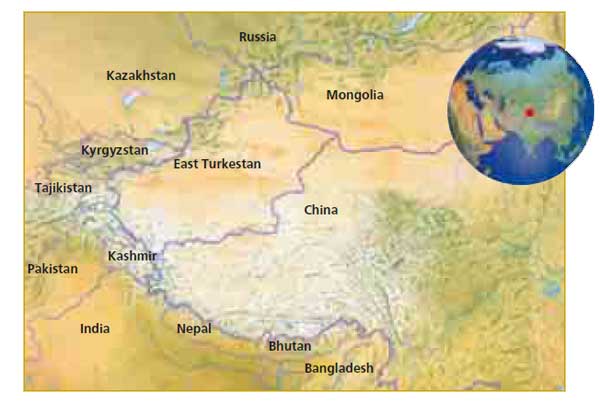 |
The history of the lands of Turkestan goes back to the third century B.C. (the Gokturk and Hun period). The area has been the Turkish homeland since very early in history, and Islamic territory for a thousand years. Although no state or khanate bearing the name of Turkestan was ever established, the area in question, which makes up a large part of Central Asia, has always been called by that name because it has been a Turkish settlement area since very ancient times. Researchers describe East Turkestan in particular as one of the first centers of civilization and, as an area where, due to its geo-strategic position, Western and Eastern cultures intermingled.
These lands, which have been home to great empires all through history, became an indispensable part of the Islamic world after the Turks converted to Islam during the reign of Caliph Abd al-malik Marwan (b. 646/647-d. 705). The years between 751-1216 A.D. in particular, after Satuk Bughra Khan (---/d. 955-6) had accepted Islam, are known as the golden age of East Turkestan. Throughout that period, students from all over the world came to study at the renowned religious schools and educational institutions of Turkestan. Statesmen and scientists who would help shape the world were also trained there. The Turks who migrated from the region to all corners of the world carried Islam with them to many different countries.
 |
| From 751 to 1216 A.D., East Turkestan was an autonomous region allied to the Turkish Hun Khanate, and enjoyed complete independence. The above map shows the routes taken by the Huns during their migrations to the south, west, and to Europe. |
 |
| The Gokturks were the first people to use the name Turks, and they spread out over a wide area, from the China Sea to the Black Sea. Turks still live in large numbers within the former boundaries of the empire, which also includes East Turkestan. |
The Qarakhan, Ghazna, Khwarezm-Shah, Seljuq and Saidi tribes that were born in Turkestan set up states under the banner of Islam and provided outstanding examples of Turkish-Islamic culture, thus rendering a great service to human kind. Prominent statesmen such as Satuk Bughra Khan (---/d. 955-956), Seljuq Bey (---/d. 1007), Mahmud Ghaznavi (b. 998-d. 1030), Malik Shah (b. 1055-d. 1092), Timur (b. 1336-d. 1405), and Babur Shah (b. 1483-d. 1530) were among the great figures who emerged from those lands. Imam Bukhari, Imam Tirmidhi, Ibn Sina (Avicenna), Abu Nasr al-Farabi (Avennasar), Narshaki, Zamakhshari and Marginani, who enriched the libraries of Islam with their works, were among the great thinkers who forged the way for other scientists of the world. Furthermore, Makhmud al-Kashgari, author of the Diwan Lughat at-Turk, Yusuf Khass Khadjib, author of the Kutadgu Bilig, and Ahmad Yuknaki, the writer of the great Atabet'ul Haqayiq, also lived in Turkestan, the cradle of Turkish-Islamic civilization. Scholars such as these, of whom we have cited only a few, are sufficient to demonstrate the importance of East Turkestan to the Turkish and Islamic worlds.
 |
| Prominent Islamic scholars such as Ibn Sina (above), Mahmud al-Kashgari (side) and Farabi (large picture) were just a few of the important figures to emerge from Turkestan. |
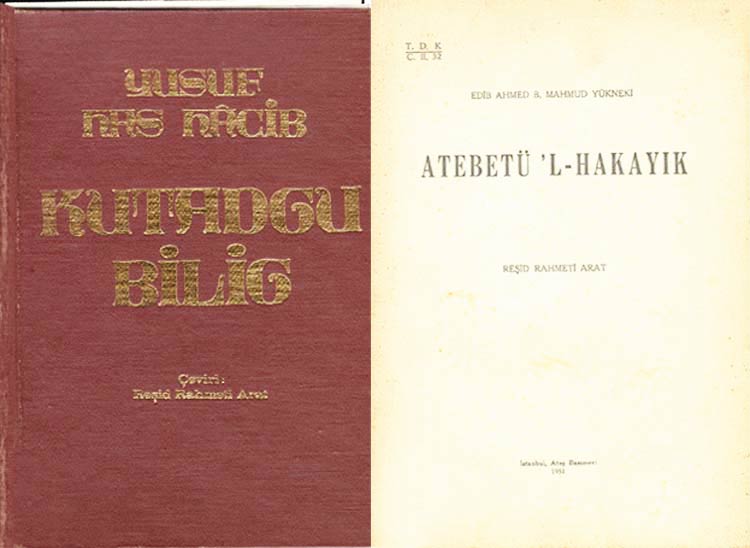 |
| Works such as the Kutadgu Bilig and the Atabet'ul Haqayiq are considered as important to world history as they are to that of the Turkish-Islamic world. |
One of the claims made by China in order to conceal its human rights violations and repression in East Turkestan is that the area "forms part of Chinese territory," for which reason events in East Turkestan "need to be considered a domestic Chinese affair." However, historical sources disprove that claim. First and foremost is the Great Wall of China, built by the Chinese to prevent attacks on them by other nations. This was the first time that China had put up an official border between itself and the peoples living around it. East Turkestan falls outside that border.5 Moreover, many sources describe the Jade Gate (so called because of the many jade stones found there), as being at China's westernmost border. One of these sources that describes the gate as opening into East Turkestan is actually a Chinese book, the New China Atlas, published in Shanghai in 1939.6
 |
| No matter how much the communist Chinese regime claims that East Turkestan forms part of its own territory, the fact that it lies beyond the Great Wall of China, which is accepted as forming that country's natural border, is just one factor that undermines this claim. |
The region between the Great Wall of China and the Caspian Sea, Siberia and Iran, and the borders of Afghanistan, Pakistan, Kashmir and Tibet has been known as Turkestan in not only the earliest Islamic records, but also in old Iranian and Indian accounts. This is also accepted by a great many Western historians. Nikita Bichurin, one of the earliest known Turcologists, has supported that historical truth in these terms: "A nation lives between the Caspian Sea and the Koh-i Nur Mountains. They speak Turkish and believe in Islam. They introduce themselves as Turkish and describe their country as Turkestan."7 Because these lands were given the name of "Xinjiang" or "Sinkiang" (meaning "new borders") following their occupation by China does not change that historical reality.
 |
| Throughout history, the Silk Road that passed through East Turkestan played an important role in the Chinese economy. Behind presentday China's wish to maintain its rule over East Turkestan lies the strategic importance of the area. |
Over the 2,000 or so years, between 206 B.C. and 1759 A.D., East Turkestan was able to maintain its independence for more than 1,800 years. During the periods when it was linked to the Turkish Hun and Gokturk khanates, local administration lay entirely in the hands of the people of East Turkestan. Between 751 and 1216 it was totally independent. During those periods China periodically occupied East Turkestan in order to win control of the Silk Road. Yet these occupations were always short-lived, and China was never able to establish hegemony over East Turkestan in the true sense of the word. In the 2,200-year history of East Turkestan, (if we take into account the occupation that started in 1934 and which is still continuing today) a little more than 570 years have been spent under Chinese occupation.8
 |
| One factor that totally undermines the claim that East Turkestan is part of China is that the Uighur Turks' language, religion, customs, way of life and culture are completely different from those of the Chinese. |
There are also geographic facts that disprove the claim that East Turkestan is part of China. The make-up of the population of East Turkestan (its language, religion, ethnic origins, plus its national and spiritual heritage) all reveal a picture of total independence from China. Panku, the great historian of the Han Dynasty (206 B.C. -- 220 A.D.), expresses this fact:
 |
As for clothing, costume, food and language, the barbarians [Uighurs] are entirely different from the Middle Kingdom… Mountains, valleys and the great desert separate them from us.9
That difference was preserved throughout history. Neither was there any assimilation, even during the periods under Chinese occupation. Today, 54 percent of East Turkestan's estimated population of 17 million are Muslims, including 47 percent of the Uighurs and 7 percent of the Kazakhs. (This figure is from statistics issued by China in 1997, and is not accepted as reliable by international organizations because of China's biased attitude toward this issue). The Uighurs, who make up a large part of the Muslim population, bear no ethnic, religious or linguistic similarity to the Chinese. The Uighur alphabet consists of Arabic letters, they are all Muslim, and they have been living by Turkish customs and beliefs for more than 1,000 years.
All of these historical, geographical and sociological facts make it clear that East Turkestan is not part of China, but rather a separate region that China has sought to assimilate. Even under the harshest and most difficult conditions, the people of East Turkestan never accepted Chinese rule, and frequently sought to regain their independence, at times even resorting to armed struggle. For example, when East Turkestan fell under Manchu rule between 1759 and 1862, the Muslim people rose up and rebelled against the Chinese more than 40 times.
Why is China so determined to maintain its position on East Turkestan in the face of all the facts? This should be discussed before turning to the long years of Chinese oppression.
| Periods of East Turkestan Independence | |
| The First Period | The period up to 206 B.C. |
| The Second Period | Local Administration under the Turkish Hun Khanate, 206-108 B.C. |
| The Third Period | Local Administration under the Turkish Hun Khanate 86-60 B.C. |
| The Fourth Period | Local Administration Under the Turkish Hun Khanate, 10 B.C.-73 A.D. |
| The Fifth Period | Complete Independence, 74-554 A.D. |
| The Sixth period | Local Administration Under the Gokturk Khanate, 555-639 A.D. |
| The Seventh period | Local Administration Under the Gokturk Khanate, 650-660 A.D. |
| The Eighth Period | Local Administration under the Turgis Turkish Khanate, 699-738 A.D. |
| The Ninth Period | Complete Independence, 751-1216 A.D. |
| The Tenth Period | Local Administration Under the Mughal Empire, 1217-1351 A.D. |
| The Eleventh Period | Complete Independence, 1351-1678 A.D. |
| The Twelfth Period | Local Administration Under the Kalmuck state, 1679-1752 A.D. |
| The Thirteenth Period | Complete Independence, 1756-1759 |
| Periods of Chinese Occupation of East Turkestan | |
| The First Period | 108-86 B.C., Limited to the South of the Country |
| The Second Period | 60-10 B.C., Limited to the South of the Country |
| The Third Period | 74-103 A.D., Limited to the South of the Country |
| The Fourth Period | 640-649 A.D., All of the Country |
| The Fifth Period | 660-699 A.D., All of the Country |
| The Sixth Period | 738-751 A.D., All of the Country and Part of West Turkestan |
| The Seventh Period | 1753-1756, All of the Country |
| The Eighth Period | 1759-1861, All of the Country |
| The Ninth period | 1879-1931, All of the Country |
| The Tenth Period | 1934-Today. |
| As can be seen from the table, East Turkestan has been under Chinese occupation only a total of 570 years during its 2,200-year history. (Isa Yusuf Alptekin, Unutulan Vatan Dogu Turkistan (East Turkestan, the Forgotten Country), Seha Nesriyat, Istanbul, 1999, pp. 90-91) | |
A basic knowledge of geography makes it easy to understand the Chinese view on East Turkestan. Two important obstacles to communications exist between China and the West: the first is the 5,000-kilometer Taklamakan Desert, and the second is the Great Wall of China that stretches along the entire length of the China border.
East Turkestan is the only Chinese territory beyond the desert and the Great Wall, thus making it China's window to the West. The political effect of its location (and its geographical and strategic advantages) make East Turkestan indispensable to China. That is one reason why, instead of withdrawing from East Turkestan, China is trying to impose their occupation on the local population by means of force and violence. On the one hand, it takes away the peoples' freedoms, including those of receiving news and communications, by closing East Turkestan off and keeping the region as far from the world's awareness as possible.
 |
| East Turkestan is known as the Kuwait of the twenty-first century, because it possesses rich underground mineral reserves. This fact makes the region indispensable for China. |
These lands, which form the westernmost point of Chinese territory, were used by the Chinese as a buffer zone against the Soviet threat during the Cold War. These lands are thus of great interest to China for its own security and that of the other countries in the region. Even if Russia no longer poses a threat to China, China still maintains its land and air forces in the region, and also keeps a large part of its nuclear arsenal there. Another important reason for the continuing presence of China's forces in East Turkestan is to maintain the necessary control over the local Muslim population.
 |
| The oil reserves in the Taklamakan Desert within the borders of East Turkestan are some of the richest in the world. |
However, geo-strategic concerns are not the only reason for China's interest in controlling East Turkestan. As noted, the region also possesses considerable natural resources, and the land is very productive. East Turkestan, known as the Kuwait of the twenty-first century, is of particular interest for its oil, natural gas, uranium, coal, gold and silver mines, and is one of China's most important sources of these resources. Authorities on the subject say that by 2005 East Turkestan will be China's second most important center of oil and natural gas production. The Tarim Basin in the middle of East Turkestan in particular is thought to have considerable petrol reserves. That basin is therefore known as the "Sea of Hope," and is estimated to have potential oil reserves of more than 10.7 billion tons.10 Research carried out by geologists has revealed a 300-million tons of oil and a 220-billion cubic-meters of natural gas capacity.11
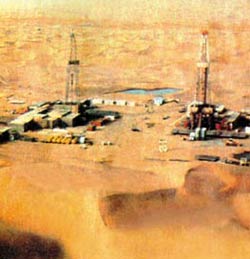 |
China's dependence on East Turkestan for energy is not restricted to the oil beds in the Tarim Basin. East Turkestan will also be the natural route for any pipeline from the Central Asian Turkish states, which will in turn be of vital importance to Chinese industry. The best way for China to insure its transportation system is effective and secure is to keep East Turkestan under its control.
The region's rich natural gas, coal, and copper deposits also make it indispensable for the Chinese economy. Of the 148 different minerals extracted in all of Red China, 118 come from East Turkestan (this is 85 percent of China's mineral production). Among these, coal, with its high quality and energy content, is especially important. The coal reserves in East Turkestan are estimated at some 2 trillion tons, half of China's total coal reserves. One study at the end of 2000 revealed that China's richest copper mines were in East Turkestan. It is a known fact that China's other regions possess little copper, and that which exists is insufficient to meet the country's needs. The rich copper deposits in East Turkestan make the region even more important in Chinese eyes.12
Alongside these mines, the fact that East Turkestan is one of China's largest producers of cotton is another reason why China regards the area as important. The Red Chinese administration is unwilling to hand over the production of cotton, the raw material of the Chinese textile industry, to the Muslim Uighurs, and constantly develops new strategies to maintain control over the region. The aim behind these strategies, which we shall be examining in detail in later chapters, is not to allow East Turkestan to develop, but to make it dependent on Beijing.
 |
| All of East Turkestan's underground resources are exploited by China. The Muslim people are unable to enjoy their share of the revenues from them. |
 |
| East Turkestan's gold, oil and other minerals are transferred to China, and the use of these natural resources is totally under the control of the communist Chinese government. |
 |
| As their sources of wealth such as oil, gold and uranium are plundered by Beijing, the Uighurs are also imprisoned in their own land. Unemployment and low levels of education are rife. Eighty percent of the population live below the poverty line. Tiny Uighur babies can at least look to the future with hope if their families have fled abroad, to such places as Turkey. |
In the preceding section we saw how East Turkestan is of great strategic and economic importance for China. Yet the frequent arrests of devout Muslims in East Turkestan, not allowing them to live in accordance with their religion, and the pressure put on their religious leaders, make it clear that there is more to their policy of oppression. First and foremost, it means that Red China is greatly concerned by the presence of Islam in East Turkestan.
Although the roots of the Chinese attacks on Islam and Muslims go far back in history, these policies were changed into a systematic policy of oppression, and even genocide, with the establishment of the communist regime. When Mao founded the People's Republic of China in 1949, all manifestations of Islam were made targets. This hostility towards Islam began with the closure of mosques, religious schools and other institutions providing religious education. The situation worsened after portraits of Chairman Mao were hung in the now empty places of worship (and Muslims were forced to show their respect for such images). Some 29,000 mosques were closed during that period.13 The following stage consisted of the arrest of religious leaders on groundless and baseless charges and accusations. Some of these were condemned to death, and more than 54,000 religious figures were condemned to work in the most terrible conditions in Chinese labor camps.14
Throughout that period, physical and mental torture was inflicted on men of faith. Some Muslims were rounded up into public squares and made to confess the so-called "divinity" of Chairman Mao (surely Allah is beyond that). The people were forced to carry out practices in flagrant violation of Islamic ideas, such as cremation of the dead. The closed mosques were used as military depots and barracks, or as places of entertainment (such as theatres and cinemas). All forms of public worship, including Friday and other prayers, were prohibited and heavy taxes were imposed on those Muslims who continued to pray in the few remaining mosques. The communist administration confiscated the alms given for the maintenance and restoration of the mosques and all the property belonging to religious leaders. Studying and teaching the Qur'an were completely banned. Religious works were seized from peoples' homes. Writings in Arabic were burned, including a large number of historical handwritten texts.15
 |
| With Mao's seizure of power, the oppression of the people of East Turkestan has turned into a systematic campaign of genocide. Mao forced the Muslim people to conform to communist ideology. One of the first steps to achieving this is the way that mosques and masjids all over East Turkestan were covered with portraits of Mao. |
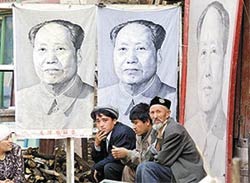 |
Modern Chinese oppression of the Muslims in East Turkestan is felt most heavily in the field of religion. As in all communist regimes, hostility to religion is part of the official state policy of Red China. A document called "The Basic Viewpoint and Policy on [the] Religious Question During Our Country's Socialist Period," circulated internally through party channels throughout China in 1982 by the Central Committee of the Chinese Communist Party, openly states that fact:
In human history, religion will ultimately disappear... All religious organizations in China will bow their heads to the leadership of the party and the government … The true aim of religious schools is to produce professional religious officials who support the party administration and the socialist system … These religious officials must remain loyal to the party's policy on religion … The fundamental purpose of religious bodies is to play an important role in spreading the country's political influence.16
A speech by Ali Jing Jiang, a member of the People's Republic of China Islamic Community, at the 5th meeting of the Islamic Society of North America in the USA on September 1, 1986, shows just how fully the Red Chinese administration has put into effect the decisions set out in that declaration. In his speech, Ali Jing Jiang stated that in China it is legally forbidden to give any religious education, either at home or at school, to minors under the age of 18. Although some religious schools have been opened as the result of pressure from Islamic countries, there are more Marxist, Leninist and Maoist ideas taught in them than Islam. Jiang expressed that all the teachers in such schools are communists and atheists and young people are being raised with no knowledge of religion. In other schools, he said, religion is taught as if it were something that needed to be forgotten, a primitive belief belonging to the lowest levels of Chinese society. That situation has rapidly begun to distance young people from religious belief. He also added that the government keeps a tight rein on Muslims' activities and that the communists are using Islam merely as a tool with which to improve relations with Muslim nations.17
The anti-religious pronunciations of the Chinese Communist Party are not new. Allah reveals in the Qur'an that the deniers who opposed the Prophet Noah, peace be upon him, attempted to belittle the believers with the words, "…We do not see you as anything but a human being like ourselves. We do not see anyone following you but the lowest of us, unthinkingly…" (Surah Hud: 27). In another verse, Allah describes how deniers believe themselves to be terribly clever:
When they are told, "Believe in the way that the people believe," they say, "What! Are we to believe in the way that fools believe?" No indeed! They are the fools, but they do not know it. (Surat al-Baqara: 13)
 |
| One of the important indications of the communist regime's hostility to religion is the way that many mosques have been closed down and used for storage since the earliest days of the regime. The picture to the side shows a ruined mosque in Hotan. |
 |
The Chinese Communist Party's attempts to portray religious devotion as "a primitive belief belonging to the very lowest levels of Chinese society," is an example of this foolishness.
While the Communist Party uses such propaganda methods, it also at the same time steps up its oppression of Muslims. Following the initiatives demanding independence in the 1990s, (the Baren uprising, the Gulja uprising) the oppression of Muslims was stepped up even further. The way these uprisings spread to the whole of East Turkestan, and the fact that Turks in public posts also supported the demands for independence, greatly alarmed Red China. It initiated another ruthless campaign against those Muslims who had backed independence movements. Hundreds of thousands of people were detained, thousands executed and tens of thousands were sent to labor camps. Michael Winchester, one of the rare journalists able to enter the region and send out a secret report about the oppression of Muslims, had this to say in an article titled "Inside Story China: Beijing vs. Islam":
 |
| 1)Türkiye 29.06.97, "CRUELTY AIMED AT MOSQUES IN CHINA" |
| The Chinese cruelty in East Turkestan is never ending. Chinese officials often halt the construction and repair of mosques, ban Muslims from engaging in communal worship, and force them to carry out practices in flagrant violation of Islamic ideas. |
Since then they have closed down unregistered mosques; forbidden the use of loud-speakers outside registered ones; banned Quranic classes for children and youths; prohibited foreign money for religious purposes; tightened exit requirements; imposed an age restriction on haj pilgrims; outlawed unauthorized religious publications; and cracked down on Communist party members visiting mosques.18
 | |
| China constantly increases its oppression of the Muslims of East Turkestan. Young Muslims, religious figures, intellectuals, and even children are detained on meaningless pretexts and usually executed without their families being informed. | |
 |  |
One Turkestan resident interviewed by Winchester (who refused to give his real name) said that since he worked in a state office he was never able to go to the mosque, and that he would be sacked if he were to be seen doing so. The reason was the increased Chinese hostility to Islam which began at the end of the 1980s. A 1997 article in the official East Turkestan newspaper, the Xinjiang Daily, set out what party members' view of religion should be:
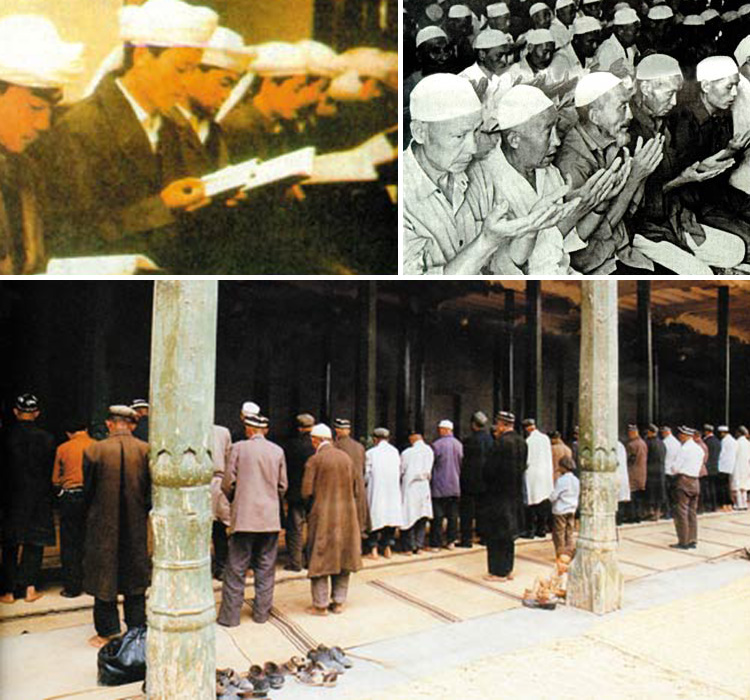 |
| Despite all the difficulties and tortures they are subjected to, the people of East Turkestan persevere by living their religion and performing their religious obligations. |
Those party members firmly believe in religion and who refuse to change their ways after education should be given a certain period to make corrections, be persuaded to withdraw from the party or dismissed from the party according to the seriousness of their case. In recent years, 98 religious party members have been dealt with.19
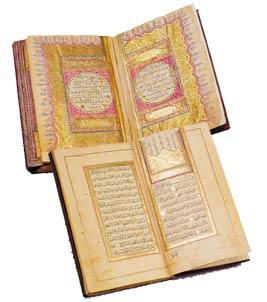 |
| The Chinese Communist Party banned the teaching of the Qur'an. |
In East Turkestan, those who are caught praying or studying the Qur'an are punished, particularly if they are aged under 18, because Chinese law explicitly prohibits minors from studying the Qur'an. In 1999, for example, five 12-year-olds were arrested for reading the Qur'an. When one of them fled from the police station, his family were arrested and tortured by the police (and told that they would not be released until he gave himself up).20 That incident is just one of the many frequently encountered in East Turkestan. Thousands of people have been detained and tortured simply for living in accordance with their religion, or for teaching other people who want to do so. The accusations made against religious figures who have been detained are particularly noteworthy. For instance, on October 28, 1999, Memet Eli, the imam of the Oybagh Mosque in Hotan, was arrested and heavily fined for teaching religion contrary to the Communist Party policy. This is how his "crimes" were set out in the indictment:
During his duty as an Imam, Memet Ali did not study, teach and implement Communist Party's regulations on religion. He pretended he did not see the instructions of department of religious supervision. When related departments organized study and educational activities for religious personals, he did not attend… He allowed people with unclear identity to stay at the Mosque…21
Other articles, as well as "failure to give instruction in communist teachings" (under which six other imams in Hotan were arrested on similar pretexts) are striking examples of the oppression faced by Muslims in Red China:
They said in their prayers: "Allah rescue your Muslim believers from the oppression of atheists." They did not stop people when they came to pray from other neighborhoods. They exceeded the 20 minutes time limit for Friday prayer and teachings. They failed to inform the authorities of people who came to get religious education."22
Mao's Hatred of Religion | |
| Like other communist dictators, Mao also denied the existence of Allah and tried to prevent the people from believing in Him. He had terrible tortures inflicted on many who believed in Allah, wanted to live by his will or tried to defend his beliefs, and resorted to all kinds of oppression in an effort to turn people away from Allah. Another side to Mao is the way that he presented himself to the Chinese people as a divine being. This common feature of atheist dictators was revealed in the Qur'an. The verses describe Pharaoh as saying, "…Council, I do not know of any other god for you apart from me…" (Surat al-Qasas, 38) The painful end of the people who grew so arrogant and saw themselves as gods has also been revealed in the Qur'an: | |
| We brought the tribe of Israel across the sea and | |
 | |
| Like other communist dictators, Mao also claimed divinity for himself (surely Allah is beyond that), and that twisted belief was stressed in posters of him. | |
 |  |
5. Owen Lattimore, Studies in Frontier History, London, 1962, p. 59 ![]()
6. New China Atlas, Shanghai, 1939, p. 51. Also see Herman Albert, Historical and Commercial Atlas of China, Harvard University Press, 1935 ![]()
7. Opisanie Cuntariy I vostoçnogo Turkestan v drevhem I nineşnem sostaynaniy, Prevedono s Kitaykogo, Petersburg, 1829, Vol I, pp. 10-11, cited in Alaeddin Yalcinkaya, Somurgecilik ve Panislamizm Isiginda Turkestan (Turkestan In the Light of Imperialism and Panislamism), Timas Yayinlari, 1997, Istanbul, p. 28 ![]()
8. Isa Yusuf Alptekin, Unutulan Vatan Dogu Turkistan (The Forgotten Land East Turkestan), Seha Yayincilik, Istanbul, 1999, p. 91 ![]()
9. Pan Ku, The Account of Hsing-nu, Han-Shu, 91 Sect. 2 p. 32 a-b ![]()
10. China Daily, April 26, 1999 ![]()
11. China Daily, January 4, 1999 ![]()
12. "China's Largest Copper Reserve Found in Xinjiang," www.uyghuramerican.org/economy/chinaonline oct62000.html ![]()
13. The Los Angeles Times, December 1, 1983 ![]()
14. The Los Angeles Times, December 1, 1983 ![]()
15. Yusuf Han, Sotsiyalistik Kazakhstan, Almaty, January 14, 1976, cited in "Chinese Policy, Human Rights Abuses and The Consequences," East Turkestan Information, A Publication of the Eastern Turkestan Union in Europe, www.caccp.org/et/etiu1.html ![]()
16. The People's Republic of China: Document 19: The Basic Viewpoint on the Religious Question During Our Country's Socialist Period: Issued by the Central Committee of the Chinese Communist Party on 31 March 1982 ![]()
17. Radio Free Europe/RL, 01.09.1986 ![]()
18. Michael Winchester, "Inside Story China: Beijing vs. Islam," Asiaweek, October 24, 1997 ![]()
19. Amnesty International Report, April 4, 1999 ![]()
20. "Uyghur Boys Were Arrested, Parents Were Tortured," East Turkestan Information Center, October 30, 1999 ![]()
21. "Imam Was Punished For Refusing to Teach Communist Doctrines in Mosque," East Turkestan Information Center, November 19, 1999 (emphasis added) ![]()
22. "Islam Treated Same As Falun Gong," East Turkestan Information Center, November 19, 1999 ![]()